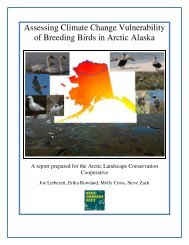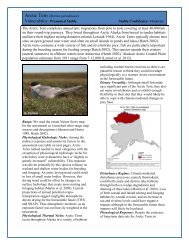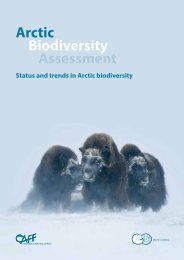Permafrost Terrain Stability and Thermokarst Monitoring: - Arctic LCC
Permafrost Terrain Stability and Thermokarst Monitoring: - Arctic LCC
Permafrost Terrain Stability and Thermokarst Monitoring: - Arctic LCC
You also want an ePaper? Increase the reach of your titles
YUMPU automatically turns print PDFs into web optimized ePapers that Google loves.
20. Burn, C.R., <strong>and</strong> Smith, M.W., 2006, Development of thermokarst lakes during the<br />
Holocene at sites near Mayo, Yukon Territory: <strong>Permafrost</strong> <strong>and</strong> Periglacial Processes,<br />
v. 1, no. 2, p. 161–175.<br />
This paper describes the formation of thermokarst lakes in the boreal forest region of the<br />
Yukon Territory using ground surveys, remote sensing, <strong>and</strong> dendrochronology. The paper<br />
describes the growth of thermokarst lakes through analysis of aerial photography <strong>and</strong> treering<br />
series obtained from submerged trees in the exp<strong>and</strong>ing lake margins. The mean axial<br />
growth rate of 16 thermokarst lakes is presented in table 1. The mean growth of lakes was<br />
0.7 m/yr along their long axis <strong>and</strong> 0.5 m/yr along their short axis. The maximum observed<br />
expansion rate was 1.2 m/yr. The expansion rate of lakes likely is not constant from year to<br />
year <strong>and</strong>, during particularly warm summers, stable banks may be reactivated <strong>and</strong> lake<br />
expansion may accelerate. Tree-ring analysis <strong>and</strong> measurements of lake talik thickness<br />
indicate that the lakes likely formed in the mid-1800s. Estimates of talik formation indicated<br />
vertical degradation of permafrost of about 0.5 to 1 m/yr. The authors provided a context in<br />
which to interpret the formation of thermokarst lakes in the region throughout the Holocene<br />
<strong>and</strong> suggested that these lakes likely were formed following a forest fire.<br />
21. Cabot, E.C., 1947, The northern Alaskan coastal plain interpreted from aerial<br />
photographs: Geographical Review, v. 37, no. 4, p. 639–648.<br />
This paper describes the utility of black <strong>and</strong> white, vertical <strong>and</strong> oblique aerial photography<br />
for describing permafrost-related l<strong>and</strong>forms in northern Alaska. There is a brief discussion<br />
on the formation of lakes <strong>and</strong> ponds in the region, elongation of lakes, drainage of lakes, <strong>and</strong><br />
a lake cycle. The author noted the role of floating lake ice pans <strong>and</strong> mechanical erosion of<br />
shorelines in the expansion of lakes <strong>and</strong> the role of bank overflow during breakup as a key<br />
process for lake drainage.<br />
22. Chen, W., Chen, W., Li, J., Zhang, Y., Fraser, R., Olthof, I., .<strong>and</strong> Chen, Z., 2012,<br />
Mapping Aboveground <strong>and</strong> Foliage Biomass Over the Porcupine Caribou Habitat in<br />
Northern Yukon <strong>and</strong> Alaska Using L<strong>and</strong>sat <strong>and</strong> JERS-1/SAR Data, Remote Sensing of<br />
Biomass - Principles <strong>and</strong> Applications, Dr. Lola Fatoyinbo (Ed.), ISBN: 978-953-51-<br />
0313-4, InTech, DOI: 10.5772/19219.<br />
This article used L<strong>and</strong>sat imagery <strong>and</strong> remote sensing techniques to map the aboveground<br />
biomass <strong>and</strong> foliage biomass of the range of the Porcupine caribou herd. The area includes<br />
part of the <strong>Arctic</strong> Wildlife Refuge on the <strong>Arctic</strong> Coastal Plain, Alaska, <strong>and</strong> western Yukon<br />
<strong>and</strong> Northwest Territories, Canada. Field studies were done to ground-truth satellite images<br />
in the middle of the growing season. Habitat characteristics were measured <strong>and</strong> those<br />
characteristics were related to satellite images of the same area to predict biomass across the<br />
entire range. Measured aboveground biomass ranged from 10 to 100 t/ha for sparsely<br />
forested woodl<strong>and</strong>s, 1 to 100 t/ha for low-high shrub sites, <strong>and</strong> 0.5 to 10 t/ha for mixed<br />
graminoids-dwarf shrub-herb sites. Biomass was similar on the calving <strong>and</strong> breeding<br />
grounds for the Porcupine caribou herd, which was greater than what is available to the<br />
Bathurst caribou herd. This may explain partially why the Bathurst herd leaves their calving<br />
grounds soon after giving birth, while the Porcupine herd stays at their calving grounds<br />
much longer, <strong>and</strong> Porcupine herd calves grow faster <strong>and</strong> weigh more than Bathurst herd<br />
calves.<br />
10








